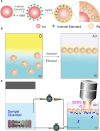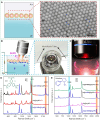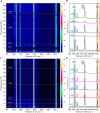Self-assembled core-shell nanoparticles with embedded internal standards for SERS quantitative detection and identification of nicotine released from snus products
- PMID: 38601887
- PMCID: PMC11005032
- DOI: 10.3389/fchem.2024.1348423
Self-assembled core-shell nanoparticles with embedded internal standards for SERS quantitative detection and identification of nicotine released from snus products
Abstract
Surface enhanced Raman spectroscopy (SERS) is a unique analytical technique with excellent performance in terms of sensitivity, non-destructive detection and resolution. However, due to the randomness and poor repeatability of hot spot distribution, SERS quantitative analysis is still challenging. Meanwhile, snus is a type of tobacco product that can release nicotine and other components in the mouth without burning, and the rapid detection technique based on SERS can reliably evaluate the amount of nicotine released from snus, which is of great significance for understanding its characteristics and regulating its components. Herein, the strategy was proposed to solve the feasibility of SERS quantitative detection based on self-assembled core-shell nanoparticles with embedded internal standards (EIS) due to EIS signal can effectively correct SERS signal fluctuations caused by different aggregation states and measurement conditions, thus allowing reliable quantitative SERS analysis of targets with different surface affinity. By means of process control, after the Au nanoparticles (Au NPs) were modified with 4-Mercaptobenzonitrile (4-MBN) as internal standard molecules, Ag shell with a certain thickness was grown on the surface of the AuNP@4-MBN, and then the Au@4-MBN@Ag NPs were used to regulate and control the assembly of liquid-liquid interface. The high-density nano-arrays assembled at the liquid-liquid interface ensure high reproducibility as SERS substrates, and which could be used for SERS detection of nicotine released from snus products. In addition, time-mapping research shows that this method can also be used to dynamically monitor the release of nicotine. Moreover, such destruction-free evaluation of the release of nicotine from snus products opens up new perspectives for further research about the impact of nicotinoids-related health programs.
Keywords: SERS (surface enhanced Raman spectroscopy); internal standards; liquid-liquid interface; nicotine; snus.
Copyright © 2024 Tian, Zhao, Shen, Shang, Pan, Dong, Huo, Zhu and Tang.
Conflict of interest statement
Authors YT, XS, SS, GD, and DZ were employed by Technology Center of China Tobacco Yunnan Industrial Co., Ltd. Author YP was employed by Hongta Tobacco (Group) Co., Ltd. The remaining authors declare that the research was conducted in the absence of any commercial or financial relationships that could be construed as a potential conflict of interest.
Figures







Similar articles
-
Simultaneous extraction and surface enhanced Raman spectroscopy detection for the rapid and reliable identification of nicotine released from snus products.Anal Methods. 2021 Dec 2;13(46):5608-5616. doi: 10.1039/d1ay01601f. Anal Methods. 2021. PMID: 34806734
-
The volatile release evaluation of nicotine from snus products under different storage conditions based on surface-enhanced Raman spectroscopy technology.RSC Adv. 2023 Aug 1;13(33):23130-23137. doi: 10.1039/d3ra03977c. eCollection 2023 Jul 26. RSC Adv. 2023. PMID: 37533785 Free PMC article.
-
Liquid-liquid interfacial self-assembled Au NP arrays for the rapid and sensitive detection of butyl benzyl phthalate (BBP) by surface-enhanced Raman spectroscopy.Anal Bioanal Chem. 2018 Aug;410(21):5277-5285. doi: 10.1007/s00216-018-1184-6. Epub 2018 Jun 25. Anal Bioanal Chem. 2018. PMID: 29943263
-
Bioorthogonal surface-enhanced Raman scattering flower-like nanoprobe with embedded standards for accurate cancer cell imaging.Anal Chim Acta. 2023 Mar 15;1246:340895. doi: 10.1016/j.aca.2023.340895. Epub 2023 Jan 25. Anal Chim Acta. 2023. PMID: 36764777
-
DNA-embedded Au-Ag core-shell nanoparticles assembled on silicon slides as a reliable SERS substrate.Analyst. 2014 May 7;139(9):2207-13. doi: 10.1039/c3an02116e. Analyst. 2014. PMID: 24627887
Cited by
-
Advancing SERS as a quantitative technique: challenges, considerations, and correlative approaches to aid validation.Nano Converg. 2024 Aug 17;11(1):33. doi: 10.1186/s40580-024-00443-4. Nano Converg. 2024. PMID: 39154073 Free PMC article. Review.
References
LinkOut - more resources
Full Text Sources
Miscellaneous

